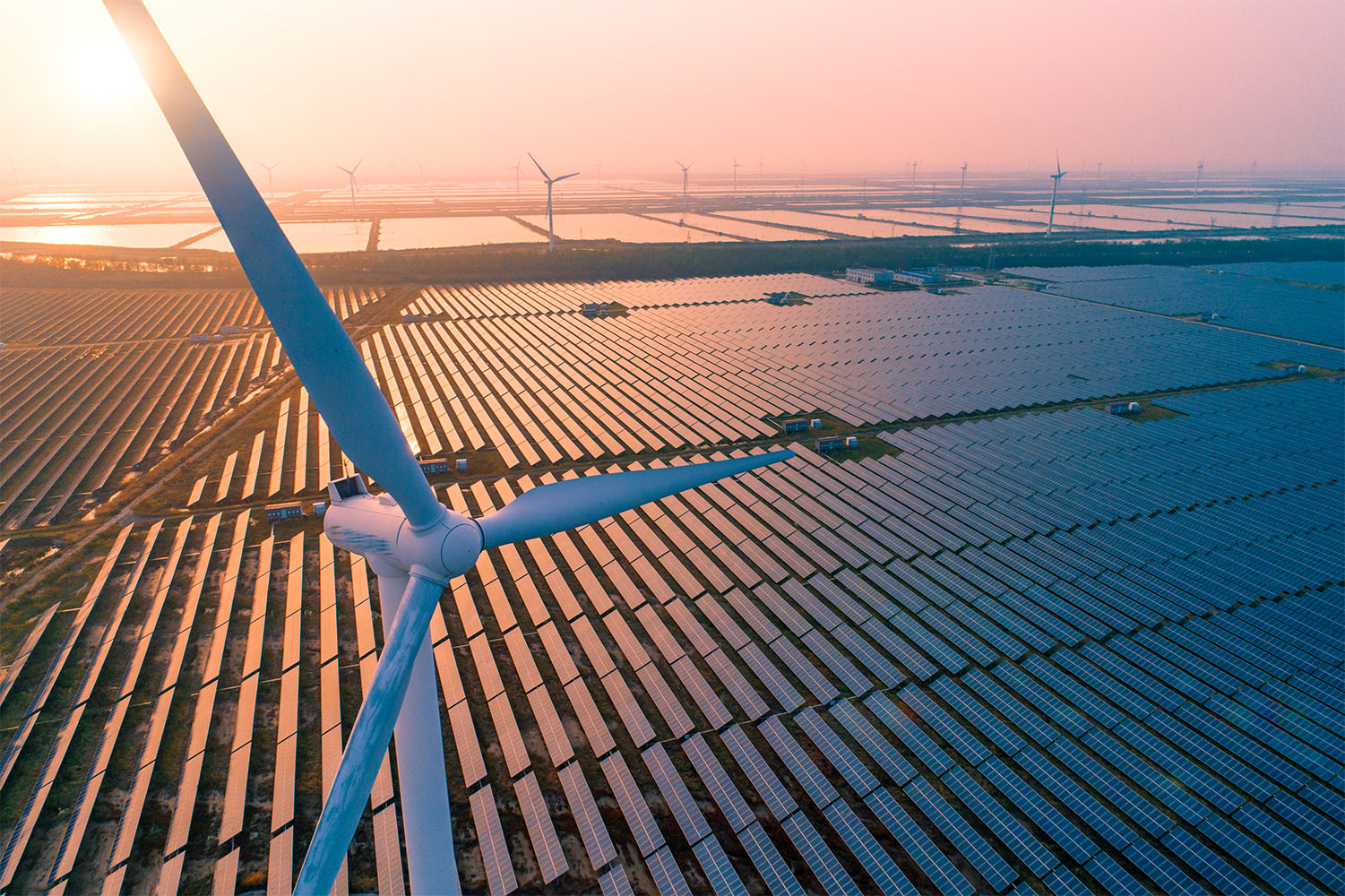Harnessing the breeze: co-location could unlock the potential of UK onshore wind
Published on 7th October 2024
Co-location offers an opportunity to boost the drive towards net zero and innovative ways to maximise efficiency

The development concept of co-location refers to the practice of situating multiple projects or infrastructure in the same geographic location. In the context of renewable projects, this includes co-location of new wind projects alongside other energy generation facilities, such as solar and battery storage. It can also include renewables that are co-located with data centres and nature-based initiatives.
Picking the ‘right’ site?
Developers are often faced with tough questions when weighing up co-location and will have a range of factors to consider.
In terms of land use, the grouping of infrastructure together is often perceived to have a greater environmental impact on the landscape and character of rural settings than developing individual projects. Developers also have to grapple with the suitability and constraints of the area chosen for the project, including availability of resources for power generation (such as wind and solar) and grid connections with their associated import and export capacity.
Co-location also requires developers to address the projects viability in the early stages. It often needs higher initial investment and outlay of capital, which can also be influenced by the choice of planning consenting route.
In July, the new Labour government made a significant initial step in its policy for renewable energy with its lifting of the de facto ban on new onshore wind projects. However, onshore wind developers applying for new connections today are likely to be given a prospective connection date in the mid-to-late 2030s.
Do these lengthy delays put more emphasis on the need for greater consideration of co-location? And what does re-purposing existing grid connection offer in terms of multiple types of generation?
Co-location benefits
With the cost efficiency it offers through shared infrastructure and optimised land use, co-location can seem a sensible option for developers. Not only can building a co-located project streamline negotiations with landowners through the use of the same area of land for both projects but it can offer a more attractive generation and delivery profile for "private wire" off takers. If the onshore wind project is co-located with solar and battery energy storage system (BESS) solutions, then the peaks and troughs of wind and solar generation will naturally be smoothed.
The most significant block to onshore wind projects had previously been the requirement in the National Planning Policy Framework (NPPF) for full community backing before consent was granted. While the de facto ban has been lifted, the underlying local concerns for wind projects may still remain. Using co-location is likely to result in fewer, less densely "populated" numbers of turbines per site, which could appease local concerns around visual effects and landscape character.
The consenting route
The consenting route for co-located generation and energy parks will depend on generating capacity. Generating stations under section 14(1)(a) and 15 of the Planning Act 2008 – those with 50MW or more of capacity, excluding energy storage, which does not count as "generation" for these purposes – will constitute a nationally significant infrastructure project and need to be consented by the secretary of state. Those that fall short of this capacity will need to gain planning permission via the Town and Country Planning Act 1990.
Determining what counts towards the capacity output will be fundamental in steering the consenting route. Developers will need to consider some of the following factors: the geographical proximity of the generating stations, the sharing of infrastructure (for example, underground connections and grid export cables, as well as onsite substations), and the interdependence of one "project" on the other.
Additional considerations?
Co-location requires careful consideration of the compatibility with connection agreements. While it is important that the connection agreement has sufficient export capacity to manage generation, the reality is that the agreement will curtail the ability for the BESS to discharge during generation. As such, the priority of assets will have to be determined contractually and strategically.
The offtake strategy must also be reviewed. Onshore wind projects might look to secure long-term revenue through a corporate power purchase agreement (PPA) or the contract for difference (CfD) mechanism (with an underlying PPA). Both PPA and CfD options would raise concerns that the export from the wind turbines could be compromised by power being diverted to or competing with the BESS asset.
Nature-based co-location
Co-location can also encompass nature-based solutions, such as those which are complimentary to the increasing biodiversity net-gain proposals emerging alongside solar projects. There is a debate over whether the government should be going further to explore how renewable projects can work and incentivise investment in areas such as peatland restoration projects, rather than viewing the two as incapable of co-existing (which is a perspective that is suggested by question 74 of the NPPF consultation).
The NPF4 in Scotland already encourages renewable projects on peatland if they contribute to greenhouse gas reduction, there is a locational need, and restoration mechanisms are explored.
Data centre piggybacking
The Department for Science, Innovation and Technology very recently classified data centres as critical national infrastructure (CNI), which was the first such designation in almost a decade.
Provided developers can balance the separate development considerations for data centres, this express backing of CNI status provides the perfect opportunity for renewable developers to piggyback on the priority of this infrastructure and seek to develop generation assets alongside new data centres. The UK government has recognised the importance of its approach to the development of data centres, including their location, which have formed part of its consultation on the proposed reforms to the NPFF that closed in September.
Food production and security
The National Farmers Union already recognises that renewable generation can help to diversify revenue for farmers. In July, the trade association Solar Energy UK published a series of factsheets on solar farms to dispel common misconceptions associated with this renewable technology, after energy secretary Ed Miliband took issue with the argument that they are a threat to national food security.
Moreover, larger and more efficient wind turbines arguably offer a greater ability to co-locate wind with other purposes such as food production, which helps with the 'food security lobby'.
Osborne Clarke comment
As a currently untapped potential for onshore wind’s deployment or redeployment, there should be greater policy support and guidance for co-location. Currently the NPPF fails to provide guidance on how applications should be considered; and National Policy Statement for renewable energy infrastructure, or EN-3, focuses on co-location in the context of offshore developments.
That said, the dial does seem to be slowly turning on this issue. The Crown Estate's Future of Offshore Wind report references co-location as a solution for meeting the anticipated demand in offshore wind and sets up a dedicated discussion forum. With onshore wind projects now treated on a level playing field, we may soon see a similar model.
Whether co-location is the key to unlocking onshore wind will remain to be seen. Regardless, by understanding the intricacies of co-location, developers can better position themselves to take advantage of the innovation and efficiencies.






